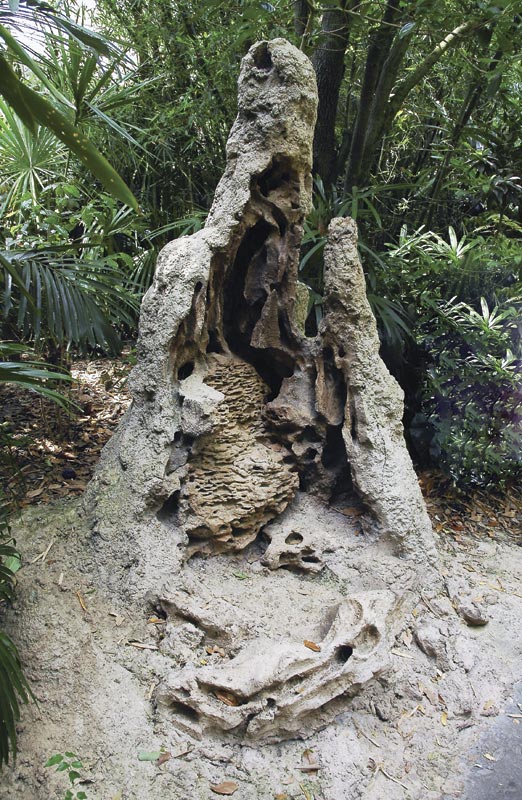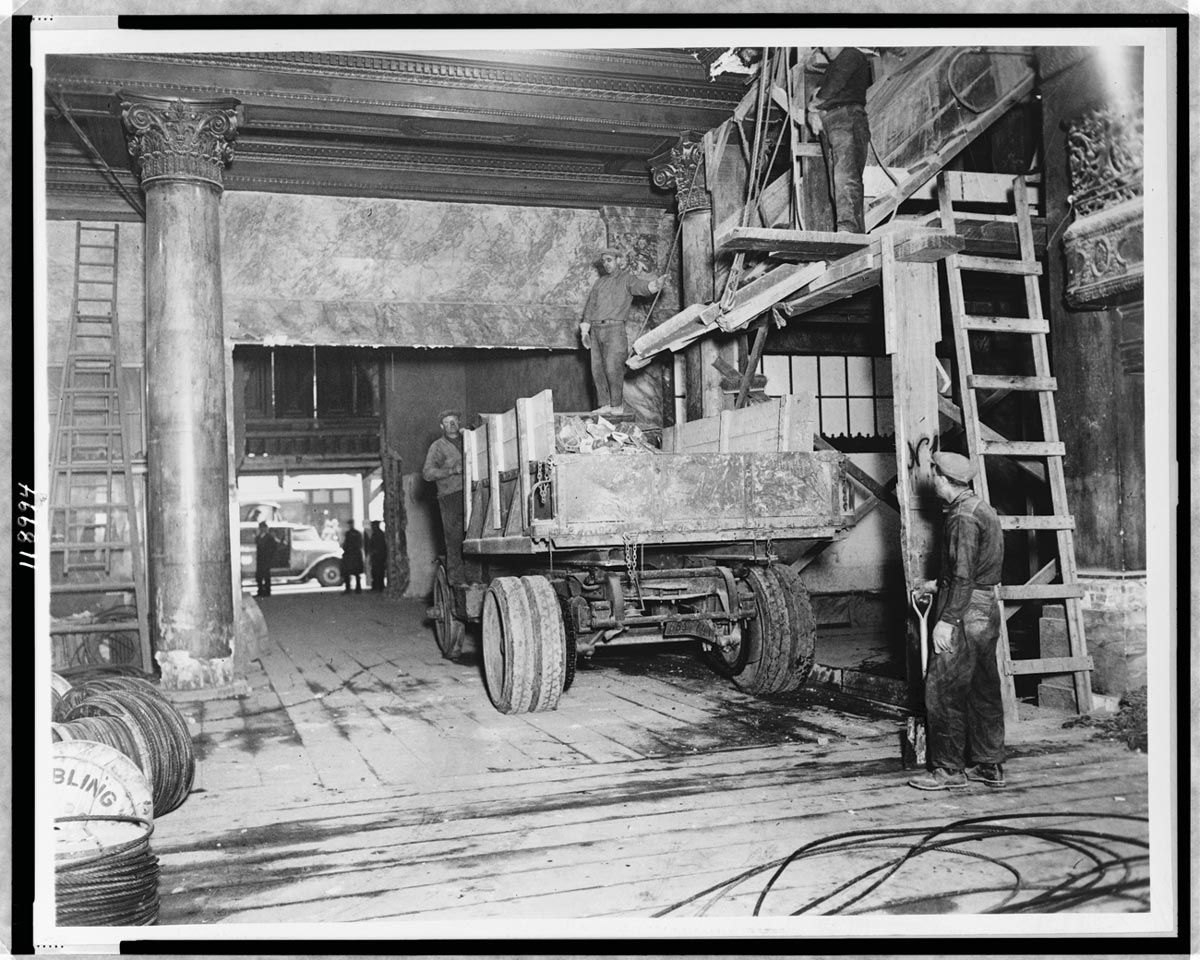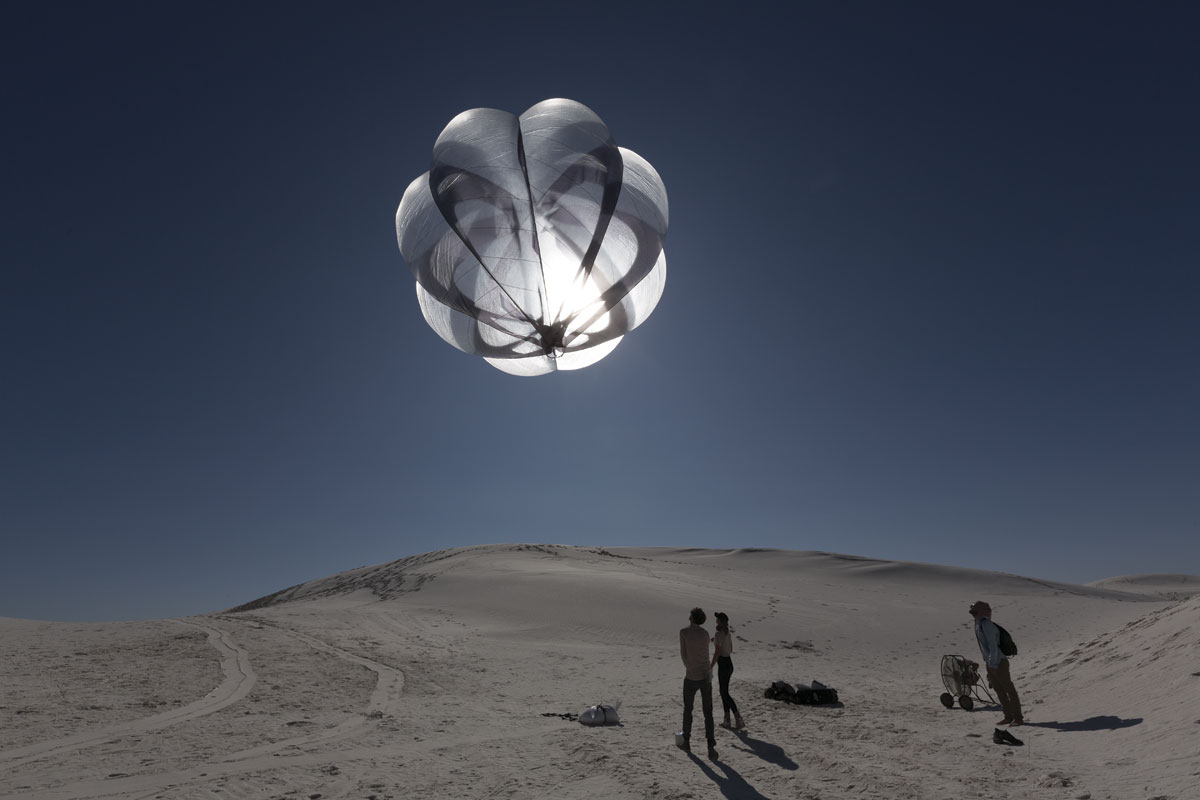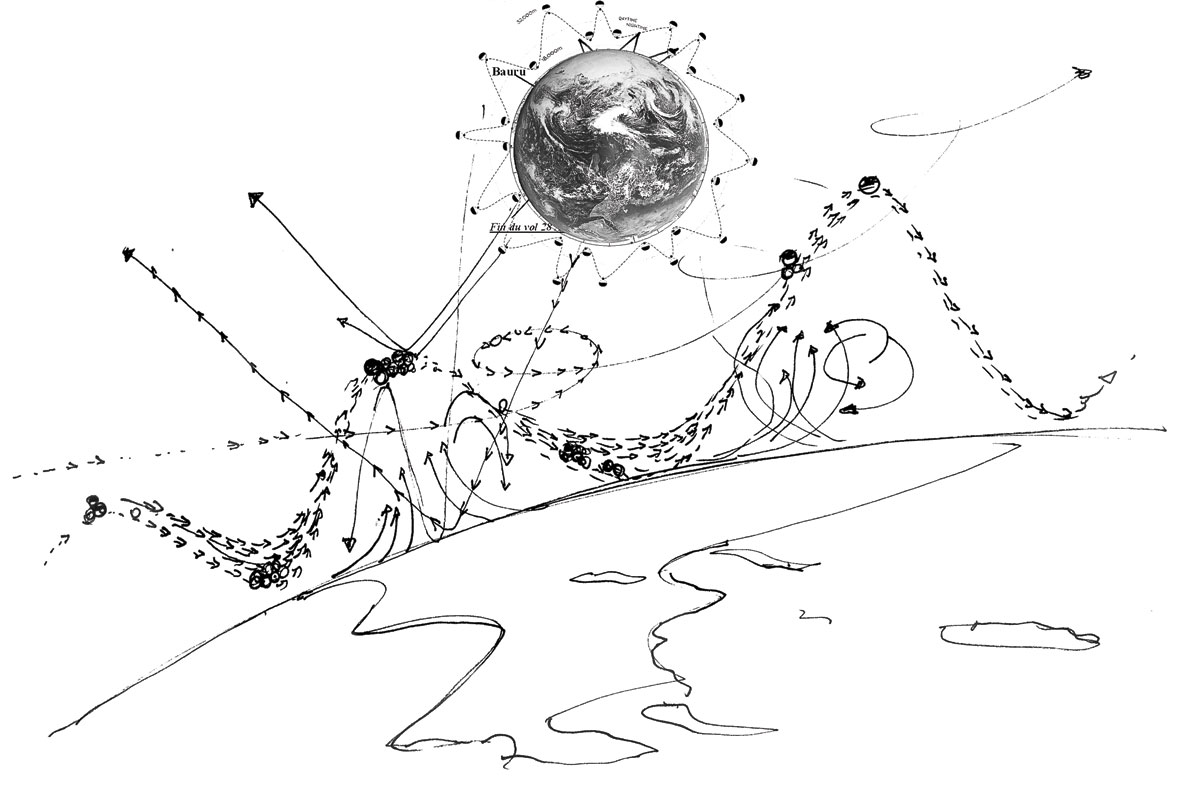The anticipation of future use is the impetus for storage. When we store objects, money, materials, energy, or information—as hoarders, librarians, or art collectors; in batteries, banks, DNA, or hard drives—we are staking future advantage on what we store today. Typically, we store to release ourselves from avoidable expenditures and work—to make life easier later. A range of perspectives on storage, from that of ecosystem science to world system sociology to architecture to contemporary sculpture, can provide unique insight into the magnitude of material-energy dynamics inherent to storage. In such contexts, examining the nature and function of storage can help us better reason and imagine our roles as designers.
Superorganism I
Biologists Bert Hölldobler and E. O. Wilson consider a whole colony of termites as the effective functional organism of the species, a “superorganism.”[1] They describe this superorganism as constituted by distributed cognition and functioning organs within the termite collective. The reproductive queens are the genitals, for example, while forager termites act as the superorganism’s anterior field of metabolic intake. The termite mound builders of the colony are effectively pheromone-organized, 3-D printers of the dirt-mound habitus of the colony. The resulting mound is itself the lung of the superorganism. This last “organ” is quite astonishing in its storage design.
Termites have poor lungs and are particularly sensitive to carbon dioxide levels. Thus the modulation of diurnally accumulating gases is central to mound life. To avoid having to constantly exhaust foul air—and thus to free themselves to perform additional work for mound life—termites externalize ventilation to the exosomatic design of the mound.
A Termite Nest
Recent research documents how, by varying the porosity and thickness of internal and external clay walls of the mound, termites can vent carbon dioxide through pores too small for predators and wind but large enough for diffusive ventilation of the toxic gas. [2] Whereas the human lung uses the elasticity and muscles of the lung to dissipate gases (a soft system), the termite mound uses the elasticity of thermal and pressure oscillations of the ambient environment as its pump (a hard system). As the sun strikes the varied surface thickness of the mound, a convective cell is created between thin-walled outer channels and thicker-walled inner channels that serve to ventilate the mound. The storage dynamics of these hard and soft systems are inherent to their respective overall metabolic dynamics.
But it would be a mistake to think of the superorganism dynamics of the mound as the limit of its design. Termite mounds are not closed systems; they find beneficial associations with trees and shrubs in their environment. These plant systems intake excess moisture and gas from the mound system while the termite system in turn sources fungi from within the tree as food. In turn, human lungs intake the “waste” oxygen from the tree, which in turn intakes our “waste” carbon dioxide and stores, or ossifies, it in the cellulose of its trunk and branches—the source of fungi development in the tree. How these adjacent systems couple for mutual advantage is as important as any internal function to the mound or tree or human. It ultimately becomes difficult to discern where the superorganism stops in this ceaseless, nested set of sources and sinks.
Biology is replete with such trade-offs between various sources and sinks. In the superorganism of life, any accumulation or storage of gases, heat, water, or clay is matched with its corollary dissipation. In this context, storage is provisional, and its calibration is design. Form—whether it is a termite mound, hurricane, or city—is that which most powerfully stores and dissipates an available gradient of matter-energy. A number of other super- and not-so-super-organisms in our environments illustrate some salient roles and opportunities for storage.
Superorganism II
Like any building, the original Waldorf-Astoria Hotel in New York City was, ultimately, a geological endeavor. [3] By considering this emblematic building, we begin to see that buildings are super, but only in terms of the order of magnitude of their material and energetic inputs. Their exchanges and feedbacks with adjacent systems are not as super or mutually beneficial.
To make way for the hotel in 1892, some 13,933 tons of brick and stone masonry from existing masonry row houses and two mansions belonging to the Astor family were removed from the site. Then, over the course of hotel construction (1892–1896), some 51,709 tons of masonry and stone were sourced, extracted, moved, and installed. Even at the end of the 19th century, the material geography of the Waldorf-Astoria Hotel was planetary in scope, with many components arriving from far-flung continents. The hotel was a sink of super-scaled, geographically distributed sources.
The magnificent pile of Waldorf-Astoria masonry would not persist for long, however. Storage never does. In 1929, after 35 years of occupation, the hotel was demolished to accommodate the Empire State Building and its 22,175 tons of stone and brick masonry (to say nothing of its steel, concrete, and glass). Add to this the replacement Waldorf-Astoria built farther north, on Park Avenue, and the total geological sourcing, extraction, accumulation, and dissipation of this material storage becomes even more apparent.
As part of its demolition, masonry from the “obsolete” hotel was trucked down 33rd Street, loaded onto barges, and dumped 11 miles off the coast of Sandy Hook, New Jersey, where the material remains today. This particular form of storage—dumping—is one of the salient tendencies of current urbanization ecologies, but one that eliminates mutualities or future use. This uneven exchange of matter and energy that is constitutive of our source-sink systems associated with the building and unbuilding of our cities is central to the “metabolic rift” of modernity’s built environments. [4] Designers have been trained to externalize feedback and thus opportunities for coupling and mutualities, like the mound and tree in the termite example, much to our peril. The faux autonomy of design today precludes the ecological vitality that we can observe throughout the world.
While a systems ecologist or a world-system sociologist would study the accumulation and dissipation of matter-energy in building, architects do not readily think of building and urbanization as storage—as massive sinks of matter-energy. Some very cunning designers fancy the thermodynamic and fluid dynamic potential for buildings to store heat and humidity. But few, if any, mind (or mine) the architectural and urban potential of bulk materials, or their planetary mass flow, considered over long durations.
Truck being loaded with debris of remains of the Waldorf-Astoria Hotel, New York City, New York, 1929. Courtesy, The Library of Congress
The storage of daily fluctuations of heat and humidity are central to any sane future ecology of architecture, but the orders of magnitude of energy associated with these important sources of comfort and delight need to be scaled against the energy associated with the geologic movement of a building’s mass. According to ecosystem accounting of buildings, 80 percent of the energy associated with building is related to the extraction, production, transportation, assembly, and disassembly of materials; only 20 percent is related to operational energy, like heating or lighting. [5] Storage, by orders of magnitude, is the more important energetic consideration in terms of ecology. While designers have started to amend the thermodynamics of buildings by modulating the velocity of heat and air in buildings, they have not yet begun to modulate the velocity of building materials, or the velocity of building and unbuilding. These much larger orders of magnitude in urban accumulation and dissipation are far more consequential energetically and ecologically, however.
The notion that a building is a temporary sink of matter and energy, and not an eternally fixed deposit of mass, may appear surprising or possibly metaphorical to some. But once the extraction, movement, processing, assembly, demolition, and deposition of known quantities of material is established, it becomes obvious that a building is more building—an active verb rather than a fixed noun. Building is a dynamic process of urbanization and ecology—a Lagrangian flow more than a Cartesian solid.
For instance, the brick used for the original Waldorf-Astoria traveled a total of 80 miles—from its extraction and processing to its temporary storage as part of the hotel structure—before being sunk off the coast of New Jersey. With its duration fixed, the average velocity of the masonry is around 2.3 miles per year. Multiply this figure by the masonry’s 45,031 tons of mass and the momentum is established. There is an inverse architecture of this movement—a very real dynamic of matter, space, and time that has a definite form—but this movement and form is as yet unspecified or designed by architects.
Ecology suggests that the longer matter-energy remains in a system (a forest, building, or city), the more “mature” and efficacious the system is.6 The relative residency of matter-energy in a system is an indicator of how much work or use can be extracted from any particular component of a system. In the case of the Waldorf-Astoria, this could be as simple as the number of people, or generations, that make use of the building for accommodation or entertainment. Thus, stored matter and energy is often an indicator of more complex interactions that develop over time and introduce degrees of freedom for other work in the system. The future use of this storage—either in the case of an entire repurposed building like the Pantheon, or repurposed materials like some of its stone columns—are essential to the “residency time” of building as storage. This does not preclude novel structures forming within the system. In fact, it may well be the basis of the emergence of such structures.
Like the termite mound that exploits the elasticity of its ambient milieu, we can couple the ambient environment with the mass of a building through design, as in the case of a naturally ventilated building. We can also couple the elasticity of planetary mass flow of building with contingent systems of forestry and mining through design; and the design of our specifications in particular. The complexity of this coupling is essential to a more cosmopolitan characterization of design today. Buildings are of course not reducible to storage in this sense, but they are utterly dependent on it. Regardless of whether architects continue to externalize these dynamics from the project of architecture, the dynamics are nonetheless inextricably related in reality. Many factors influence how and why humans either store or dissipate great piles of matter in buildings and cities. But the velocity and relative orders of magnitude of that storage and dissipation are key ecological indicators for civilization—the superorganism of building and urbanization.
The material and building history of the Waldorf-Astoria demonstrate how we fail as an organism to develop cunning feedback and mutualities through the design of large-scale material-energy organizations like building and urbanization. Presently, our current building environments and processes are, again, super, but only in scale and the orders of magnitude of matter-energy involved. They are not yet super in terms of feedback designs. We have not learned to design a building to couple with its surroundings and thereby develop superorganism mutualities.
Left: Waldorf-Astoria, New York City, New York, 1893. Courtesy, The New York Public Library
Right: Waldorf-Astoria, New York City, New York, 1897
Superorganism III
Tomás Saraceno’s Aerocene project (2015–ongoing), in which he envisions not only mobility but civilization itself aloft in the atmosphere, is astonishing in regard to how it couples its forms with adjacent systems. Foremost is the degree to which his experiment manifests the salient principle of thermodynamics—that the universe abhors a gradient—as the motor of its operation. [7] A gradient is an energetic difference. The universe tends to obliterate such difference. But very interesting things happen between systems—such as the emergence of form and life—in the process of canceling out these available gradients. All forms in the universe can be understood as emerging from constitutionally open and coupled dynamics, having evolved in these infinite cascades of energy gradients.
Saraceno imagines forms of human habitation and mobility aloft in the planet’s most abundant but lowest-quality gradients of available energy on the planet: the aero-solar gradients diffused everywhere in the atmosphere. [8] Taking the superabundance of low-quality energy—solar energy that has barely warmed the top layers of the earth’s atmospheric thermal cushion—as his primary energetic reserve and thus his point of departure, Saraceno and his team design ways to tap into this tropospheric storage-sink as the source of reimagining habitation and mobility. Within this context of superabundance, Saraceno envisions a powerful model of collective life based on extracting maximal work for living from a ponderously low-quality source.
The urbanization of this low-quality but abundant storage is a spectacular and mesmerizing basis for form, one that reimagines how storage can be put to work in human-involved life. This gradient can do types of work with far less energy, by orders of magnitude, than that of our current petroleum paradigm—and with very different mutualities and feedbacks. Saraceno suggests using the elasticity of insolation, jet streams, and climate change as the engine and source of energetic work. [9] To name just one pertinent dimension of this project, Saraceno inverts the problem of climate change—the radiative forcing that, we are told, threatens the quality of life on this planet—into the increasingly available gradient that will support many aspects of life in his aero-polis. [10] The almost-nothing of our atmosphere that threatens everything through climate change becomes, in the Aerocene, the fuel for a different model of living. The Aerocene helps us imagine other ways to engage storage to float the operations of life.
Tomás Saraceno, Aerocene launch, White Sands, New Mexico, 2015 © Studio Tomás Saraceno
(Not-So-) Superorganism IV
These three cases reveal how storage and dissipation are coupled and how matter and energy are exchanged between sources and sinks at many simultaneous spatial and temporal scales. Ideally this occurs for mutual benefit. It remains for designers of the current not-so-super-organism of the built environment to imagine more ambitious and efficacious mutualities in the systems that support contemporary life. Rather than the present tendency to think like an autonomous or autarkical (“net-zero energy”) organism as designers, the respective lessons of termite mounds, the construction ecology of Manhattan, and the Aerocene provide some insight on the ecological efficacy and formal potential of thinking, designing, living, and, ultimately, storing as a superorganism.























